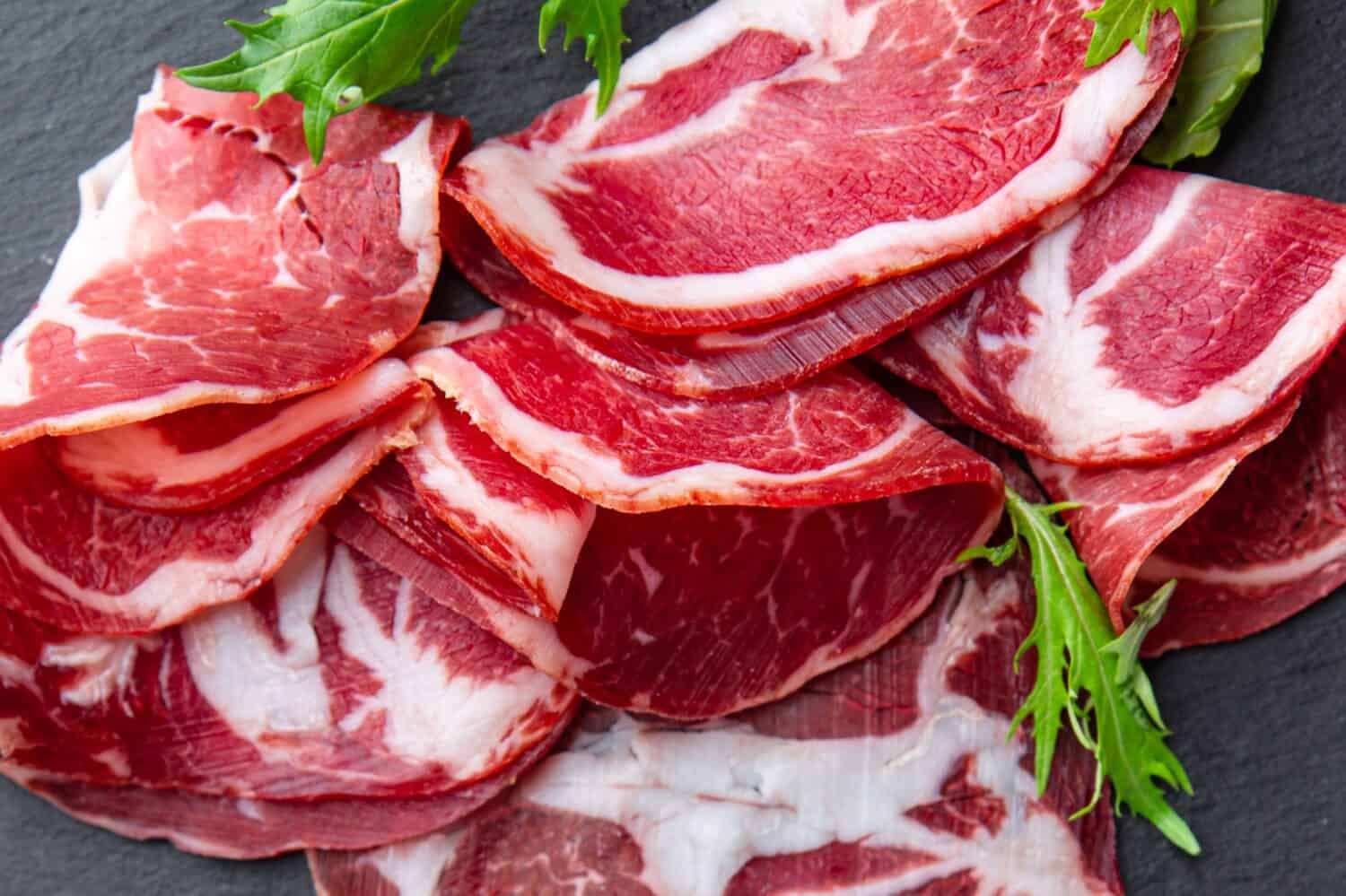Have you ever wondered about the differences between pancetta vs. prosciutto? Both are great samplings of cured meats, with an array of recipes that count on the salty, delightful meats to add flavor and protein to the mix. In terms of differences, they come from different parts of the pig and are unique in cut, texture, and nutritional content. Pancetta is cut thicker than prosciutto, which also impacts the ways in which these pork-based cuts of meat are consumed.
Read on as we learn about the history and origin of these cuts of meat. We'll talk about how they are processed and how long it takes them to cure. By the end of this, you'll get some great recipe ideas and, overall a better understanding of these cured meats' unique qualities. Never again will you question which one to use for a particular recipe. So let's get into the meat of it and cover the basic differences between pancetta vs. prosciutto.
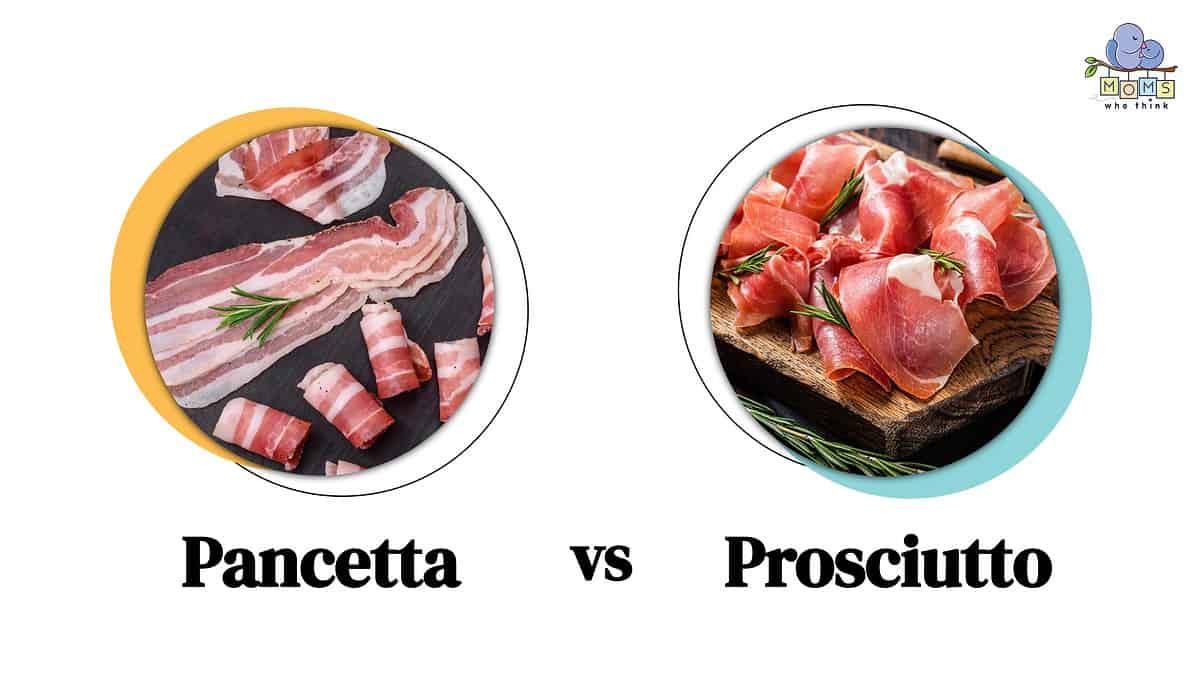
Pancetta vs. Prosciutto: What is the difference?
The major differences between pancetta vs. prosciutto come down to the part of the pig from which the meat is cut and the final product's texture. These, in turn, influence the nutritional differences between the two, as well as the ways in which they are used. One cut comes from the pig's belly meat, whereas the other is cut from the hind legs. These two parts of the pig differ in fat, muscle, and meat content. How these two cuts of cured meat are then, in turn, utilized in certain recipes. Read on.
What is Pancetta?
Pancetta is salt-cured pork meat that comes from the fatty belly meat of the pig. You may recognize it in sliced forms or in cubes, both of which are traditional for cuts of pancetta. Unlike bacon, pancetta is not smoked. However, it is seasoned with spices like cinnamon, cloves, nutmeg, salt, pepper, and even juniper berries. All of these unique seasonings contribute to the overall flavor profile of pancetta. After around three weeks of cure time, pancetta is a fatty, salty cured-meat delicacy (via Brittanica).
- The must-have convenient reference guide for every home cook!
- Includes more than 8,000 substitutions for ingredients, cookware, and techniques.
- Save time and money on by avoiding trips to grab that "missing" ingredient you don't really need.
History And Origin of Pancetta
Originally, the process of curing pancetta has roots in Italy, as far back as the Romans! Before the age of refrigerators, this was the best way to extend the life of meat in the form of salt curing. Pancetta can be regionally unique in terms of how it is flavored and how it is brined. The name itself comes from the term “pancia” which translates to “belly.” In the early processes of curing meat, the process included salt-curing the pork in a dry environment. This protects the meat from bacteria, and the salt not only extracts moisture from the meat but absorbs the tangy salt as well (via Savour And Grace).
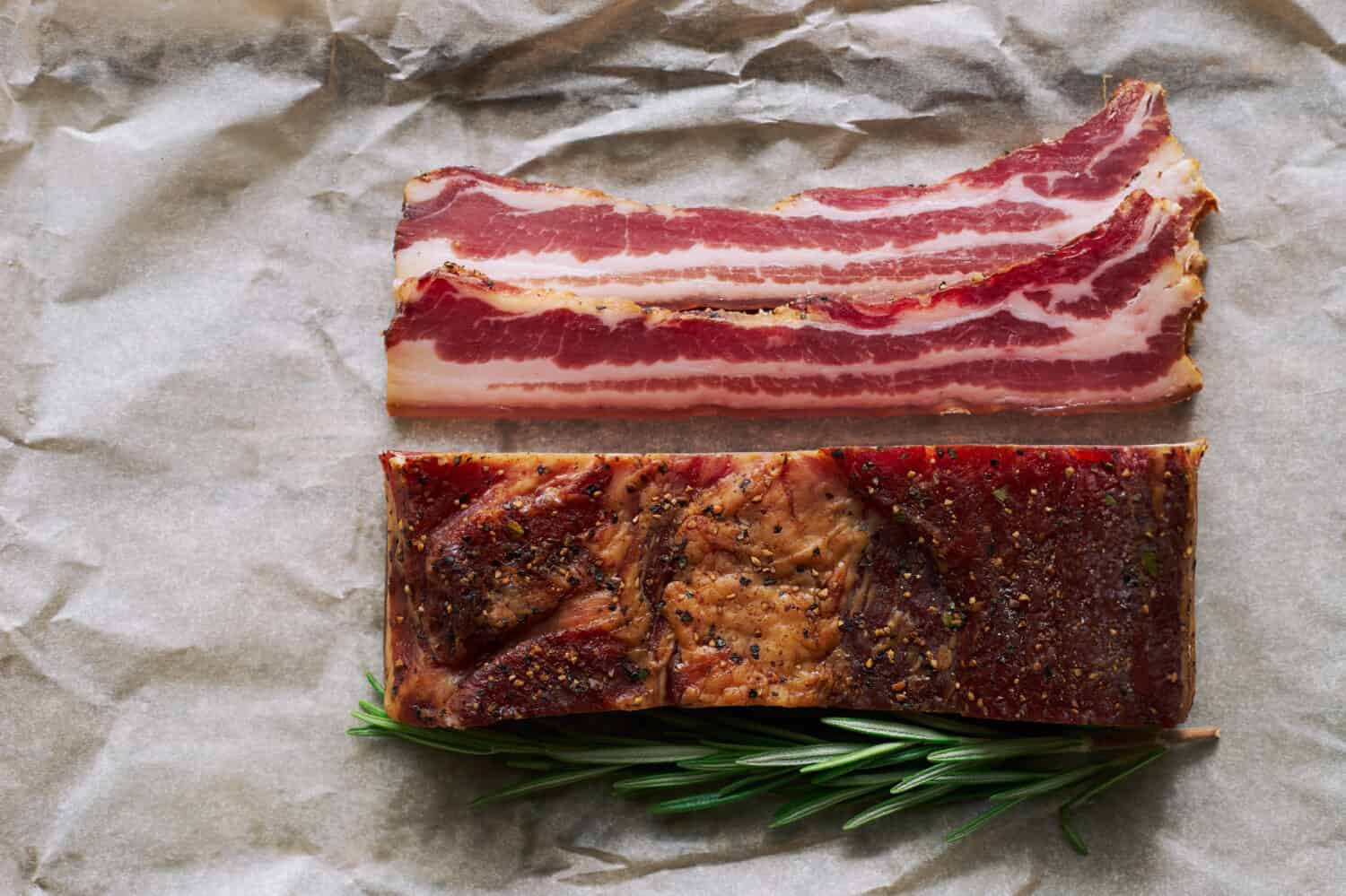
©Aleksandrova Karina/Shutterstock.com
How Is Pancetta Made?
Pancetta comes from a cleaned pork belly and is prepared with a dry mixture of salt and spices or a liquid brine made up with the same seasonings. Traditional pancetta includes spices such as cinnamon, juniper, pepper, salt, and an array of other regional flavorings. Pancetta can be rolled or cured flat, and the curing process takes between 2 weeks to 6 months, depending on the style. The rolled variety is often served raw and thinly sliced or crumbled as a garnish. A flat pancetta is often cube-cut and included in an array of sauces, dishes, and recipes (via Volpi Foods).
Recipes Involving Pancetta
Pancetta is a traditional topping for certain Italian pasta dishes like the carbonara dish featured below. These dishes are served with toppings like parmesan cheese, pancetta, eggs, and savory black pepper. Check out some of these delectable pancetta recipes:
- Penne and Vodka Sauce
- Chicken Marsala with Pancetta
- Hearty Chicken Stew with Pancetta Gremolata
- Caramelized Brussels Sprouts with Pancetta
- Fried Peach and Pancetta Pizza
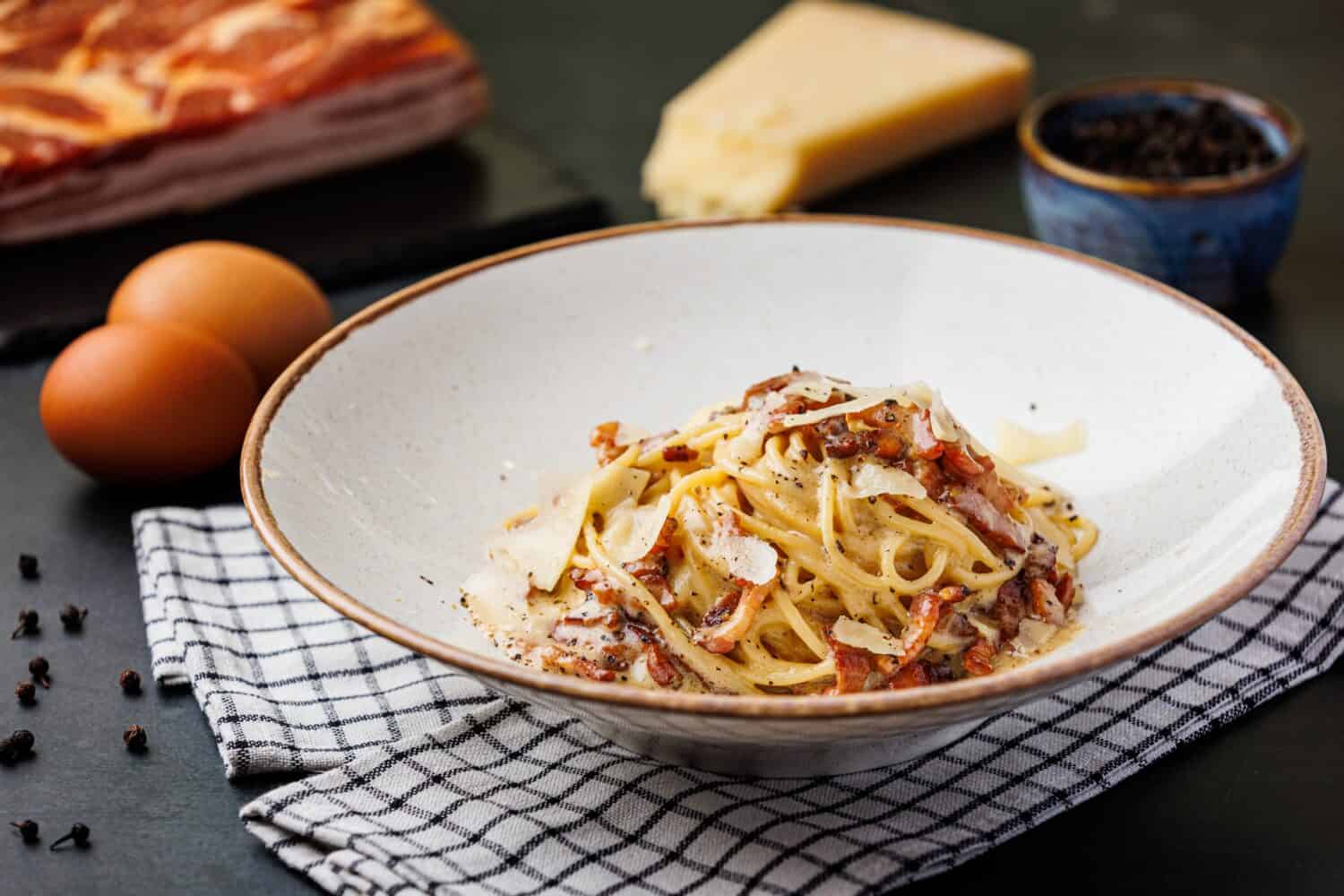
©Mihnea Tatu/Shutterstock.com
What is Prosciutto?
Proscuitto is a cured ham variety, that is typically sliced incredibly thin. The name translates to “ham,” and the cut in particular comes from the hindlegs of a pig. It is known for its concentrated flavor and lightness. In comparison to other cuts of meat, prosciutto is one of the lighter traditional salamis.
History and Origin of Prosciutto
Similarly to pancetta, the origins of prosciutto can also be traced to Italy. As far back as the Romans, curing meat was the best way to extend the life, use, and flavor of fresh meat. The process for curing prosciutto is quite similar to that of pancetta, however, the cure time is much longer. Curing techniques can vary depending on the region, and the producer. According to Eataly, the Prosciutto di Parma DOP is made from heritage-bred pigs from 11 different regions throughout Italy, and the whole thing must be processed in Parma for it to be this style of prosciutto. There are regional producers that require the prosciutto processing to be done in a specific area for it to be considered a certain category of salami. Regional factors such as altitude and pig variety can affect the taste (sweetness) and color of the ham.
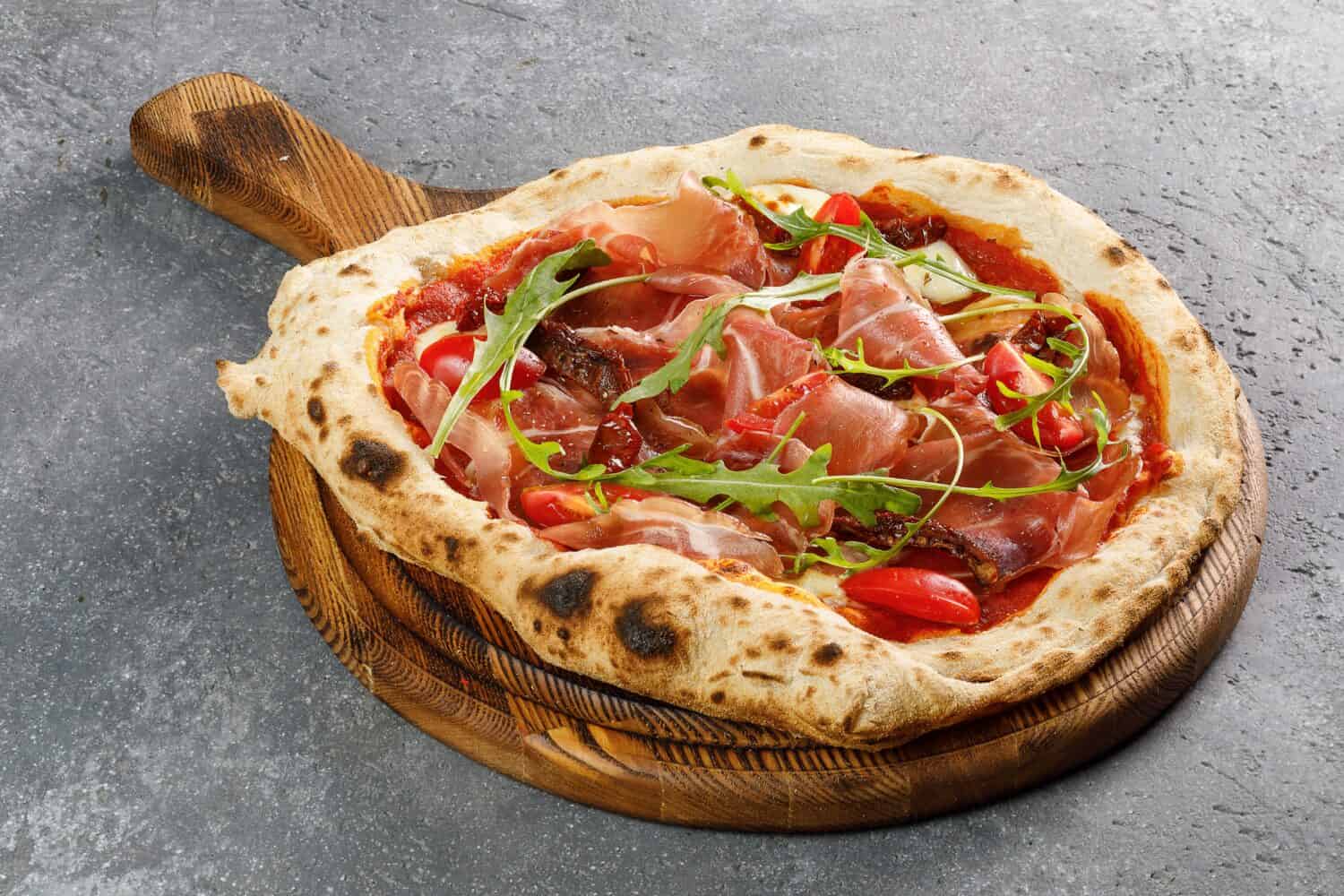
©Alexander Sherstobitov/Shutterstock.com
Recipes Using Prosciutto
The lightness and saltiness of prosciutto make it a wonderful addition to all kinds of fresh salads, fruit pairings, pasta dishes, charcuterie boards, and cooked vegetables. Traditional prosciutto uses include prosciutto-wrapped melon, in sandwiches, and a feature on charcuterie boards. Check out some of the following recipe ideas for using prosciutto in your cooking endeavors:
- Chicken Saltimbocca with Mushroom Sauce
- Cheese-Stuffed Chicken Breasts
- Creamy Lemon Pappardelle With Crispy Prosciutto
- Peach and Prosciutto Sandwich
- Prosciutto-wrapped Asparagus with Raspberry Sauce
- Arugula Pizza
Nutritional Value of Pancetta vs. Prosciutto
Refer to this handy chart below to compare the nutritional value of pancetta vs. prosciutto. 3 ounces of pancetta are higher in calorie count, fat, and saturated fat content. Prosciutto on the other hand has more protein, which is likely due to the cut location of the meat. Because pancetta comes from the stomach, it makes sense there is a higher fat content. Also, the way in which it is processed, and the thinly sliced nature of prosciutto means it is delivering less in terms of fat, and calories.
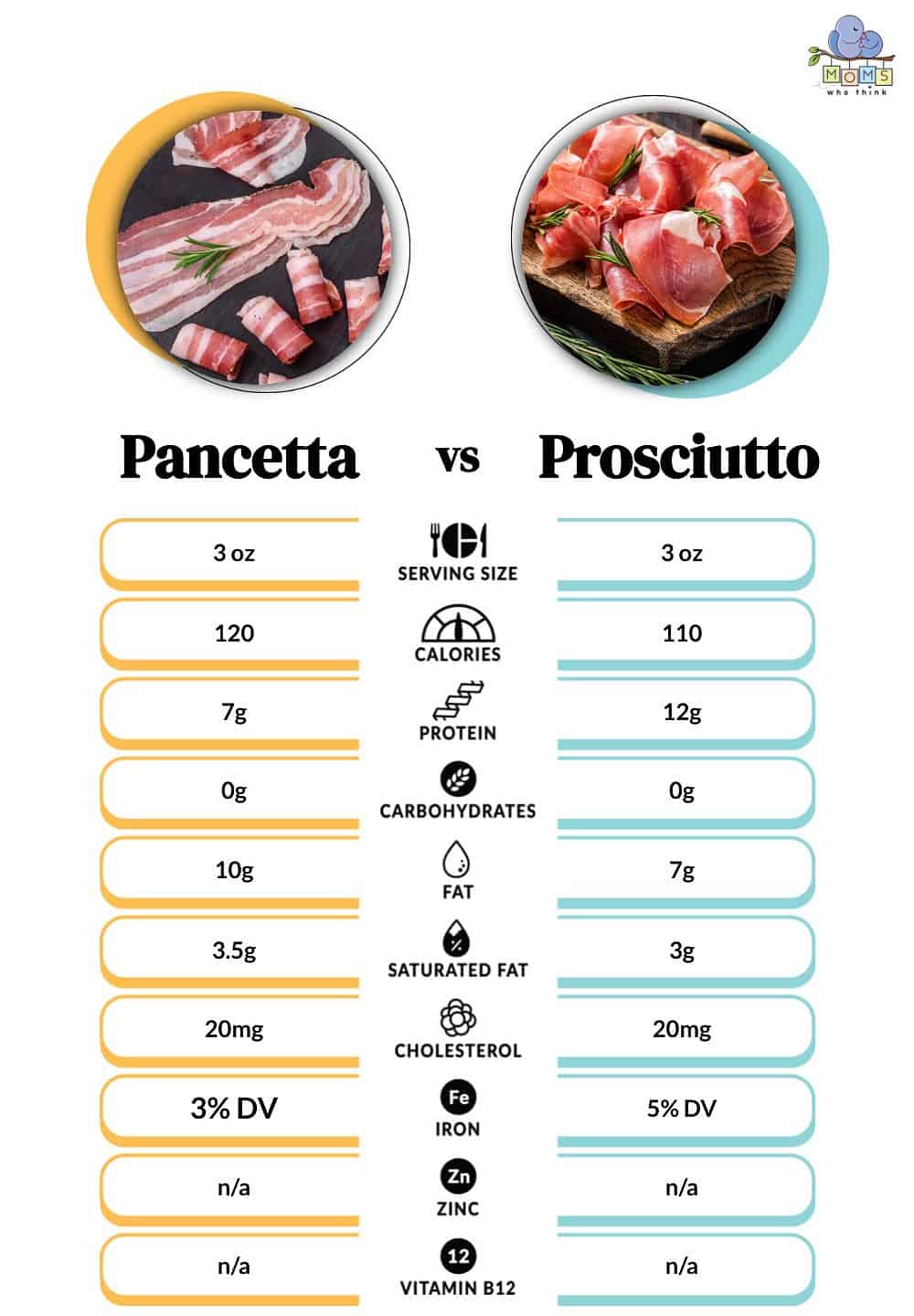
Pancetta vs. Prosciutto: Are They The Same Thing?
While pancetta and prosciutto are both cuts of cured pork, they are different enough in terms of appearance, taste, texture, and where on the pig they are cut from. While you could substitute shredded prosciutto in a salad for cubed pancetta, there are certain recipes that pair better with the thinly sliced prosciutto compared to the fatter, creamier pancetta. Pancetta is wonderful in sauces, and as a topping, both are good on pizza, and there are numerous ways to go with using either. The bottom line is that both pancetta and prosciutto are both delicious, delectable cured pork meats, and while they are different, they are both fantastic ingredients to know how to use.
Possible Alternatives to Pancetta and/or Prosciutto
If neither pancetta nor prosciutto is really what you're looking for, there are truly so many alternatives. We've already touched on bacon, though the flavor and texture will be slightly different. There's salami, capicola (neck muscle), guanciale (pork cheek), culatello (pork filet/leg loin), cured jámon serrano, and more. There's also dried beef bresaola, and chorizo, in regards to non-pork options. Soyrizo is a non-meat alternative for those interested, and there are some amazing recipes out there for turning banana peels (yes!) into something resembling vegan bacon.
Recipe Card
When cooking, it's important to choose the correct ingredient between pancetta and prosciutto as they have vastly different uses. Let's take a look at one delicious recipe using prosciutto.
- The must-have convenient reference guide for every home cook!
- Includes more than 8,000 substitutions for ingredients, cookware, and techniques.
- Save time and money on by avoiding trips to grab that "missing" ingredient you don't really need.
Chicken Saltimbocca with Prosciutto and Mushroom Sauce
Ingredients
- 1/2 cup all-purpose flour
- 1/4 teaspoon salt
- 1/2 teaspoon pepper, divided
- 8 boneless skinless chicken thighs (2 pounds)
- 2 Tablespoons olive oil, divided
- 2 cups sliced fresh mushrooms
- 2 thin slices prosciutto or deli ham
- 1/2 cup chopped shallots
- 2 garlic cloves, minced
- 1 cup white wine or reduced-sodium chicken broth
- 1 cup reduced-sodium chicken broth
- 1/3 cup half-and-half cream
- 3 Tablespoons fresh sage or 3 teaspoons dried sage leaves, divided
- 1 can (15 ounces) white kidney or cannellini beans, rinsed and drained, divided
- 1/4 cup water
Instructions
1. In a large resealable plastic bag, combine the flour, salt, and ¼ teaspoon pepper. Add chicken, a few pieces at a time, and shake to coat.
2. In a large skillet over medium heat, cook chicken in 1 Tablespoon oil for 6 to 8 minutes on each side or until juices run clear. Remove and keep warm.
3. In the same skillet, sauté the mushrooms, prosciutto, shallots, and garlic in remaining oil until tender.
4. Stir in wine. Bring to a boil; cook until liquid is reduced to about ⅓ cup, about 10 minutes.
5. Stir in broth. Simmer, uncovered, for 5 minutes or until slightly reduced.
6. Stir in cream and 2 Tablespoons sage; heat through (do not boil).
7. Meanwhile, in a small saucepan, lightly mash ½ cup beans; add the water. Stir in the remaining pepper, sage and beans. Heat through.
8. Add chicken to the mushroom mixture and heat through. Serve with beans.
The image featured at the top of this post is ©Alesia.Bierliezova/Shutterstock.com.
- The must-have convenient reference guide for every home cook!
- Includes more than 8,000 substitutions for ingredients, cookware, and techniques.
- Save time and money on by avoiding trips to grab that "missing" ingredient you don't really need.
